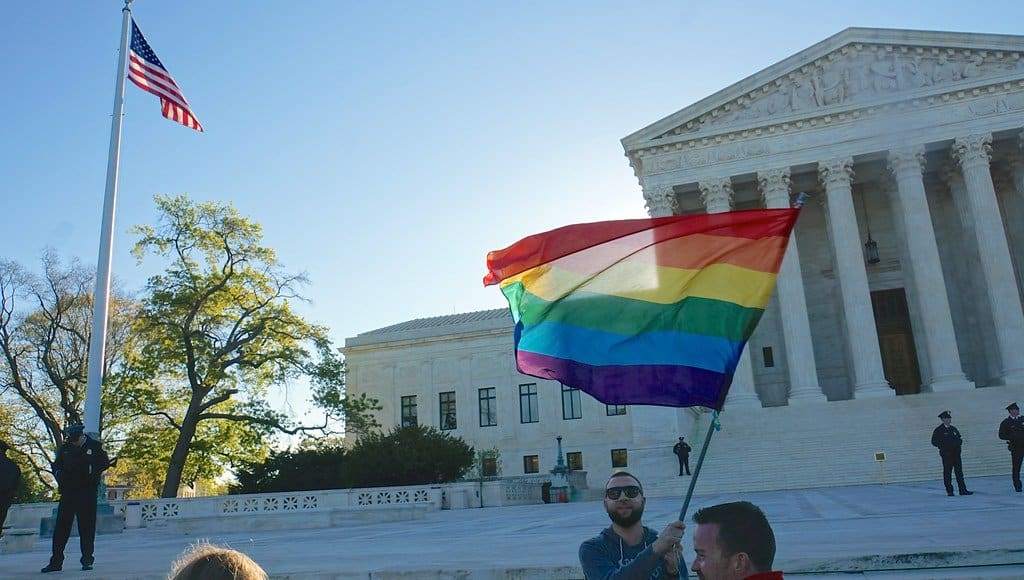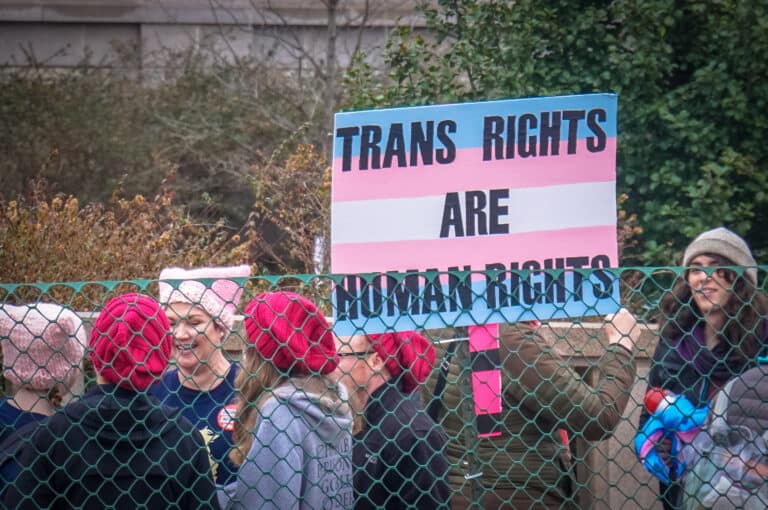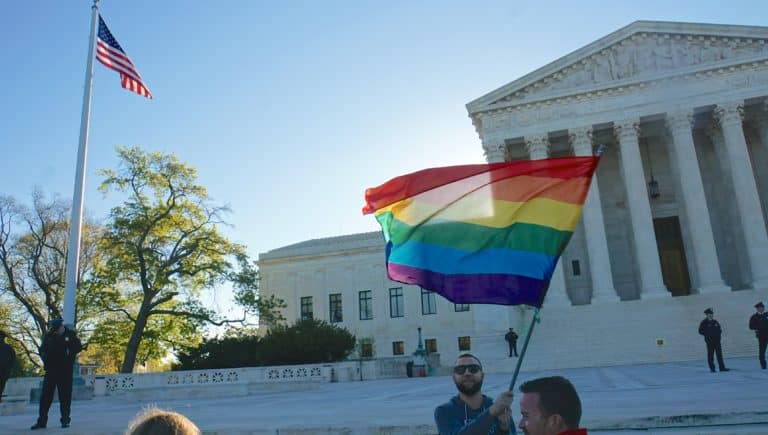On October 8 the Supreme Court will hear oral argument in Bostock v. Clayton County, Altitude Express Inc. v. Zarda, and R.G. & G.R. Harris Funeral Homes Inc. v. Equal Employment Opportunity Commission. The question presented in Bostock and Zarda is whether Title VII’s bar against employment discrimination “because of . . . sex” extends to discrimination because of sexual orientation. The question presented in Harris is whether the same provision extends to discrimination against transgender people either because of their gender identity or based on sex stereotyping as set out in Price Waterhouse v. Hopkins.
OnLabor will have continuing coverage of these three cases over the next year. Today we summarize the opening briefs submitted in support of the LGBTQ employees. Four upcoming posts will cover the amicus briefs.
Opening Briefs of LGBTQ Employees
Bostock’s and Zarda’s briefs advance three theories for how discrimination because of sexual orientation is discrimination because of sex: but-for, associational, and sex stereotyping.
First, an employer discriminates because of sex when it treats a male employee dating or attracted to a man differently than a female employee dating or attracted to a man. But for the employee’s sex, he would not have faced the adverse action. Sexual orientation discrimination thus fails the “simple test” established in Manhart, which asks whether the employer treated the employee “in a manner which but for that person’s sex would be different.”
Second, an employer discriminates because of sex when it treats the same employee differently depending on whether the employee is dating or attracted to a man or a woman. Just as courts have found that discrimination because of one’s association with a person of a particular race (as in interracial relationships) constitutes racial discrimination, discrimination because of one’s association with a person of a particular sex (as in homosexual relationships) constitutes sex discrimination.
Finally, an employer discriminates because of sex when it relies on stereotypes about who employees of a particular sex should want to date. Six justices in Price Waterhouse indisputably held that sex stereotyping is a form of sex discrimination under Title VII, and Bostock and Zarda were fired in violation of Title VII because they were men that failed to meet the expectation that men should only be attracted to women.
These theories demonstrate that sex discrimination and sexual orientation discrimination are inextricably linked. Consequently, reading Title VII to exclude coverage of sexual orientation discrimination would leave lower courts with an unworkable rule.
Both briefs emphasize that Title VII explicitly affords protection to “individuals” rather than classes. The fact that an employer equally discriminates against men and women because of their sexual orientation does not relieve it of liability. Unlawful discrimination occurs when an individual faces a disadvantageous term or condition of employment that someone of the opposite sex would not. If a man loses his job for being attracted to a man while a woman would not, that violates Title VII. The associational discrimination cases for race demonstrate the principle: an employer who fires a white employee for dating a black person and a black employee for dating a white person has violated Title VII in both instances.
They also both reject the original public meaning approach to statutory interpretation, under which sex discrimination would be limited to its conception in 1964. They underscore the Court’s unanimous decision in Oncale, in which Justice Scalia recognized that Title VII’s bar against sex discrimination covers same-sex sexual harassment even though it was “assuredly not the principal evil Congress was concerned with when it enacted” the law.
The briefs take different approaches to analyzing congressional activity since Title VII’s passage. Bostock’s brief argues offensively. First, it says that House and Senate reports from the enactment of the 1978 Pregnancy Discrimination Act indicate that the law’s purpose was to broaden the definition of sex discrimination to in order to cover “all forms of employment discrimination based on sex,” even those left unenumerated. Second, when Congress passed the Civil Rights Act of 1991, it ratified the expansive definition of sex discrimination established in Newport News (Title VII not limited to discrimination “that motivated its enactment”), Meritor (Title VII covers “sexual harassment” even absent economic impact), and Price Waterhouse because it left them undisturbed. Zarda’s brief reads defensively. It explains that the Court should read nothing into Congress’s failure to pass a law adding “sexual orientation” to Title VII’s list of protected categories because multiple inferences can be drawn from inaction. Moreover, the appearance of “sexual orientation” alongside “sex” in other statutes could be because Congress used two different terms for the same concept in order to guarantee coverage. Finally, Congress did not ratify a “settled understanding” that Title VII does not reach sexual orientation discrimination when it passed the Civil Rights Act of 1991, because most courts of appeals had not considered the issue and there is no evidence Congress was aware of the decisions of those that had.
First, Stephens’s brief argues that when Harris fired her because she is transgender, it did so because of her sex in violation of Title VII. Because Harris would not have fired Stephens for presenting as a woman if she had been assigned female at birth, her termination was because of sex. Second, Harris fired her in violation of Title VII because she failed to conform to sex stereotypes. In all cases where transgender employees face discrimination, the discrimination occurs because the employee does not meet the employer’s expectations of how people assigned male or female at birth should appear and behave in their daily lives.
Next, the brief asserts that there is no basis for carving transgender people out from Title VII’s bar against discrimination because of sex. First, there is no textual or structural evidence of exclusion. The text of the statute protects “individuals” as opposed to classes, so it does not matter if the employer would have fired both a transgender man and a transgender woman. Moreover, the statute’s only exception to the bar against sex discrimination, the bona fide occupational qualification (BFOQ), makes no mention of transgender employees. Second, the law draws its meaning from the clear text, even if its full range of applications was not anticipated by the enacting Congress. Title VII has been extended to protect employees from sex discrimination in multiple ways Congress may not have foreseen or intended, including cases of both different- and same-sex sexual harassment and cases in which men have been disadvantaged relative to women. While Congress has since passed up chances to explicitly protect transgender people under Title VII, it has also rejected opportunities to exclude transgender people from its scope. And the appearance of “gender identity” as a term distinct from “sex” in other statutes only indicates that Congress was taking a “belt-and-suspenders approach” to ensure coverage, even though sex alone would have been sufficient.
Finally, the case is not about the legality of sex-specific employment rules. Here, the facts demonstrate that Harris terminated Stephens because she was transgender, not because she failed to comply with the dress code for men, nor was the question of sex-specific policies presented.










Daily News & Commentary
Start your day with our roundup of the latest labor developments. See all
July 4
The DOL scraps a Biden-era proposed rule to end subminimum wages for disabled workers; millions will lose access to Medicaid and SNAP due to new proof of work requirements; and states step up in the noncompete policy space.
July 3
California compromises with unions on housing; 11th Circuit rules against transgender teacher; Harvard removes hundreds from grad student union.
July 2
Block, Nanda, and Nayak argue that the NLRA is under attack, harming democracy; the EEOC files a motion to dismiss a lawsuit brought by former EEOC Commissioner Jocelyn Samuels; and SEIU Local 1000 strikes an agreement with the State of California to delay the state's return-to-office executive order for state workers.
July 1
In today’s news and commentary, the Department of Labor proposes to roll back minimum wage and overtime protections for home care workers, a federal judge dismissed a lawsuit by public defenders over a union’s Gaza statements, and Philadelphia’s largest municipal union is on strike for first time in nearly 40 years. On Monday, the U.S. […]
June 30
Antidiscrimination scholars question McDonnell Douglas, George Washington University Hospital bargained in bad faith, and NY regulators defend LPA dispensary law.
June 29
In today’s news and commentary, Trump v. CASA restricts nationwide injunctions, a preliminary injunction continues to stop DOL from shutting down Job Corps, and the minimum wage is set to rise in multiple cities and states. On Friday, the Supreme Court held in Trump v. CASA that universal injunctions “likely exceed the equitable authority that […]